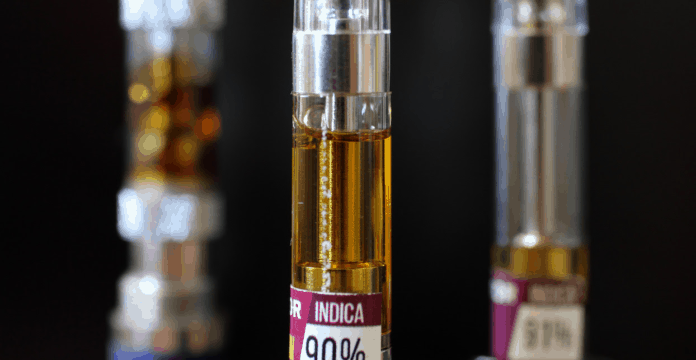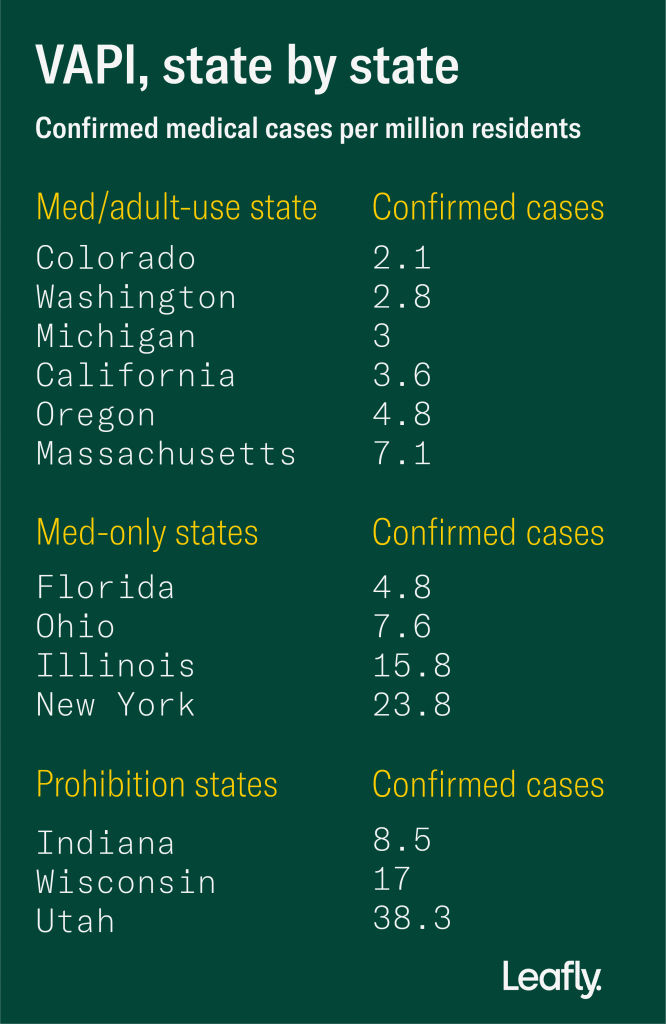Everyone who shopped for cannabis exclusively in a licensed medical or adult-use store in 2019—give yourself a pat on the back, you’re excused. As for the rest of you: Sit down.
More than 2,409 people got sick and 52 died from VAPI (vaping associated pulmonary injury, which federal authorities have relabeled EVALI) in 2019. How they got sick and died isn’t a mystery, either.
Investigators traced VAPI back to disposable vaporizer cartridges filled with tainted cannabis oil and purchased off the street in prohibition states and counties.
Vape lung injuries, mapped
Don’t let anyone get it twisted: 2019 turned out to make the strongest case ever for regulating cannabis markets. VAPI proved that testing regulations protected cannabis consumers in legal states.
This wasn’t a viral or bacterial infection. VAPI was not an “outbreak.” It was a mass poisoning that resulted from poor quality control of a popular consumer product—akin to bathtub gin, or opioids cut with fentanyl, or baby formula cut with melamine.
A new analysis compiled by Leafly from publicly available data found that cannabis prohibition states had ten times the number of vape injuries per capita as states that offered licensed, tested, and legal cannabis vape products. There have been zero confirmed VAPI cases exclusively associated with a licensed store or product in the US.
VAPI or EVALI?
Yes, we know the Centers for Disease Control is calling the lung malady EVALI, for e-cigarette or vaping lung injury.
Respectfully, we are resisting that name change. EVALI is inaccurate. The original VAPI term was changed by federal authorities in order to include e-cigarettes, which misinforms the public.
This is not an injury caused by nicotine e-cigarettes. It is caused by tainted THC cartridges bought on the street market.
Simple solution: legalize
If you want to cut VAPI cases to zero in 2020, just allow folks access to legal, licensed vaping products. It’s as simple as basic quality control, says NORML Deputy Director Paul Armentano.
“Consumers must be aware that not all cannabis vaping products are created equal,” he says. “Quality control testing is critical and only exists in the legally regulated marketplace.”
Prohibition states have 10 times more EVALI cases per capita
At the national level, vaping injuries strongly map to weak quality control over electronic drug-delivery systems. Consider the following comparisons:
Utah vs California
Utah had more than 10 times more cases of VAPI per capita than California.
The difference? Cannabis vaping products are legal in California but not in Utah. The result? Utah averaged 38 VAPI cases per million residents this summer. California averaged 3.6 cases per million.
New York vs Colorado
This ‘legal vs. prohibition states’ pattern bore out nationally. The mature legalization state of Colorado—a huge vaping state—had 2.1 VAPI cases per million residents.
New York—which has no legal adult-use cannabis market—had 23.8 VAPI cases per million residents.
Wisconsin vs Washington
Washington state, a cannabis legalization pioneer, had 2.8 VAPI cases per million residents. The prohibition state of Wisconsin, which doesn’t even allow medical marijuana, recorded 17.6 VAPI cases per capita. According to a CDC report on VAPI in Illinois and Wisconsin, “nearly all THC-containing products individuals reported using were … primarily acquired from informal sources such as friends, family members or illicit dealers.”
“It’s obviously a success story for the regulated market,” said Josh Wurzer, founder of the state-certified California cannabis testing lab SC Laboratories. “That’s maybe the positive takeaway from this whole thing.”
VAPI investigation, vape lung injury investigation
(Leafly)
Zero confirmed VAPI cases from exclusive use of licensed products
The CDC recommends not vaping anything, but officials there put particular emphasis on avoiding any vaping products purchased on the street market. That’s because of another stunning statistic that bears repeating: Investigators have confirmed zero VAPI cases exclusively associated with the use of legal state-licensed cannabis products.
California: VAPI where legal stores are banned
The state of California—which has recorded 178 cases and four fatalities from VAPI—did turn up one self-report of licensed product use. But self-reports are notoriously unreliable, and the available data shows that VAPI cases are more common in areas of the state where legal access to cannabis is still effectively restricted by local ordinances.
Because so many local municipalities have banned state-licensed cannabis stores, many Californians cannot get their hands on legal, lab-tested products. The legal market is two years old, and the illicit market is three-to-four times bigger. With only 600 licensed cannabis retailers serving 38 million Californians, many consumers still have to travel to another county to purchase cannabis legally.
The difference in safety levels between these areas is noticeable. California’s outbreak started with seven people injured in Kings County, which prohibits legal cannabis stores. By contrast, San Francisco County—a place with abundant access to legal tested vapes—has not reported a single VAPI case.
Massachusetts: Unconfirmed reports of VAPI in licensed products
In seemingly big December news, Massachusetts officials announced six VAPI cases potentially associated with a licensed product. That sounds bad, but those six cases comprise just 7% of all VAPI cases in Massachusetts—where the main culprits are illegal brands like Dank Vapes and other notorious street products.
Further examination revealed that Massachusetts investigators haven’t actually confirmed a single VAPI case associated with exclusive use of a licensed product, according to a tweet from Massachusetts Cannabis Commissioner Shaleen Title.
Investigators have to intensely follow up on self-reports, because a certain portion of patients will lie to avoid embarrassment or self-incrimination.
New York: Hundreds of VAPI cases, none from the medical market
In the best example of how testing works, look at New York, where 205 individuals have fallen sick and one has died from VAPI. How many of those victims were associated with the state’s stringent medical cannabis system? Zero
New York’s medical marijuana regulations banned the chief culprit in VAPI—vitamin E oil used as a cutting agent—at the outset of the state’s program.
“Since the investigation into the illnesses began, there have been no reports of adverse events associated with approved products in the NYS Medical Marijuana Program related to the outbreak,” said New York Department of Health Public Information Officer Jill Montag. “Medical marijuana products are approved by the Department and rigorously tested for contaminants, pesticides and concentration of cannabinoids, including, but not limited to THC and CBD.”
Related
Vape pen lung injury: Here’s what you need to know
Street vapes: Huge incentive to cheat
You don’t buy milk and meat from a stranger off the back of a truck in a dark alley. The same common sense rule applies to vaping. Where there is oversight, there’s less malfeasance.
Indeed, one reason voters across the country approve of legalized cannabis is to clean up their supply, ensuring that labels are accurate and products are pure.
Street market vape carts are not sent to certified labs for potency and purity testing. In fact, street cart makers have an incentive not to have their products tested, since there’s easy profit in fooling consumers with an impure or otherwise unsafe product. The incentive to cheat is massive, since millions of Americans vape, resulting in a multi-billion-dollar industry. SC Labs founder Josh Wurzer noted that 2019’s vape injuries often came in clusters, consistent with what you would expect from bad batches of carts purchased on the illicit market.
In the street market, the consequences of getting caught are nearly nonexistent—unless you’re arrested. While the Dank Vapes “brand” is now notorious nationwide, but it was never a legitimate, official company or organization. Illegal “Dank Vapes” makers can switch to another fake brand name in no time–it’s as easy as ordering a new batch of empty boxes on Alibaba.
Transitioning to clean cannabis in Michigan
Unfortunately, the difference between a legal, tested vape cart and a street cart is not always easy to tell. Michigan, for example, is in the middle of transitioning an unmonitored supply chain to a tested one. On Dec. 17, officials issued an unprecedented recall on vitamin E oil-tainted products. Regulators banned the thickener in THC vapes this year, but mandatory testing only kicked in May. That was too late to stop one unregulated collective from wholesaling boxes of tainted Dank Vapes to a store licensee with two locations. The Michigan Department of Health recommends avoiding all THC carts in the state at this time, in stores or otherwise.
Related
Vape pen lung disease has insiders eyeing misuse of new additives
Legal vapes: Huge incentive to stay clean
By contrast, state testing systems are set up to catch contamination—and the consequences for cheaters can be dire. Legal cart producers compete on purity and potency–the invisible hand of the marketplace, working not-so-invisibly with the guidance of state regulation. “In this case, competition completely disincentivizes anyone from doing this,” said Wurzer.
Those who break the rules pay the price. Kushy Punch, a well-known legal California brand, recently lost its license when state regulators reportedly discovered the company moving test-failed products out the back door and into the street market. (Kushy Punch officials have denied the state’s accusation. Company officials have said they were only warehousing old products. One former Kushy Punch employee, though, confirmed the state’s suspicions to Leafly.State-licensed companies also face lawsuits if a shoddy product hurts someone, and for now, that seems to be keeping cutting agents off of shelves in legal, licensed cannabis retailers. A recent test of 99 licensed Massachusetts products, done by the state, turned up zero vitamin E oil. California labs Cannasafe and Anresco Labs found no traces of vitamin E in legal supplies, nor did Confidence Analytics in Washington.
California NORML director Dale Gieringer explained the structural disincentives to dilute legal products with cutting agents like vitamin E oil.
“It’s not surprising there’s no vitamin E acetate in state-legal products,” Gieringer told Leafly. “Vitamin E is a cutting agent that’s used to dilute cannabis oil. Illicit manufacturers use it to make their product go farther. It looks like pure THC oil, so you can’t see that it’s there. But state-regulated products are tested for potency, so you know how much THC you’re getting. Therefore, vitamin E is of no use in them.”
Street dealers face no such scrutiny. Numerous reports confirm street cutters ramped up use of vitamin E oil from virtually none in 2018 to cuts of as high as 40% in 2019. Industry experts estimate about 60% of street carts, or tens of millions of units, contain the chemical, which can severely impact lung function.
2020: Work to be done
Just because legal markets proved 1,000% safer than the street market in 2019, that doesn’t mean state regulators can rest on their laurels. In 2020, legal states must further strengthen the legal supply chain’s resistance to contamination.
Basic oversight
Case in point: Washington state’s entire track-and-trace system has been broken for more than a year. That’s completely unacceptable. Oregon’s lab oversight and supply chain monitoring is also in need of significant improvement, immediately.
Proactive additive rules
Legal cannabis states must ban dangerous additives like vitamin E oil immediately.
Colorado recently moved to ban the most common cutting agents and additives—vitamin E oil, MCT oil, PG, VG, and PEG—a decision endorsed by many vape industry experts. Expect to see more legal states follow that lead soon.
Test for heavy metals
California tests for heavy metals, but few other states do. That must change, so that regulators can catch and prevent future issues with cobalt lung, lead poisoning, or other hardware failures. An unknown volume of shoddy and dangerous vaping hardware continues to arrive daily from China. Bad and medically dangerous products must be screened out of the system.
Related
California Cannabis Labs Are Finding Toxic Metal in Vape Carts
Vapor deposition testing
The industry and regulators must use more “puffing boxes”—lab testing devices to quantify the ingredients in vapor emissions, so we can analyze not just what’s going into a vape pen, but the novel chemicals emitted from them. Tests show vaping can emit far less harmful chemicals than smoking, but the hardware and ingredients must be pure and used at low temperatures and voltages. Canadian regulators recently announced that they will be initiating a testing program looking into vape emissions. If Canada can do it, there’s no reason American states can’t too.
Pesticide limits and labeling
With regard to pesticides, all state cannabis testing regulations should be standardized to meet California’s toughest-in-class Category 3 standards.
Also: Allowed ingredients disclosures must get more precise, so for example, people with allergies can avoid certain allowed ingredients—like the common pesticide neem oil.
Learn to think like a thief
Regulators must become more proactive: Imagine the next dangerous additive the street market might introduce, and prevent its spread. Think like a cutter to catch a cutter. Start randomly testing products off the shelf for emerging and potentially toxic threats.
“It’s hard to stay ahead of the black market—they’re always going to come up with new, creative ways to adulterate their products,” said Wurzer. “That’s going to affect how we regulate.”
Beware blanket vaping bans
Next year could be a banner year for overreaching vape bans that ultimately do more harm than good. Prohibition ideologues love to muddy the water on VAPI because of how clearly testing regulations protected consumers in legal states. Don’t let them. Vaping bans push both cannabis and nicotine consumers into medically dangerous street markets.
The national picture is pretty clear: Cannabis prohibition aids and abets poisoners and endangers the public—be it bathtub gin in the 1920s, or tainted THC vapes 100 years later. It doesn’t have to be this way. Consumers can be agents of their own health by avoiding dangerous street markets and working to end prohibition nationwide.
“The VAPI outbreak reinforces the need for greater regulation, standardization, and oversight of the cannabis market—principles which NORML has consistently called for in the cannabis space,” said Armentano.
David Downs directs news and lifestyle coverage as the California Bureau Chief for Leafly.com. He’s written for WIRED, Rolling Stone and Billboard, and is the former cannabis editor of the San Francisco Chronicle, as well as the author of several cannabis books including ‘Marijuana Harvest’ by Ed Rosenthal and David Downs. He co-hosts The Hash podcast. TW: @davidrdowns | IG @daviddowns




















